Using Engine Smokestacks to Estimate Photograph Dates...
12













12
|
This post was updated on .
While I believe I am fairly familiar with the various smokestack-configurations used on the engines of the DSP&P and its successors, I am having trouble locating an authoritative source for their various periods of use. While I am certain I have seen such a listing in the past, bonehead that I am, I can no longer locate it.
– Here are the smokestack configurations I'm aware of, please let me know if I have missed any: (listed in order-of-use, to my best understanding) -- Listing edited to include late additions... • Diamond • Nesmith • Congdon • McConnell ("pancake") • Straight ("shotgun") • Straight; modified with fluted cap • Straight; modified with a Como "cone" spark arrester • Straight; modified with a Ridgeway ("Bear Trap") spark arrester In addition to engine numbers and renumbering, as well as various contextual clues, I have often found it is somewhat useful to estimate the date of a photograph based on the engine smokestack in use. Of course, these dates were somewhat "soft" during transition periods when one stack was discontinued and engines were gradually refitted with the next version. Can anyone help with a possible list of dates?
Craig H. Trout
|
Don't forget between "Straight" and "Ridgeway" mid to late 19-teens. Straight; modified with a Como "cone" spark arrester. Skip Egdorf
Skip Egdorf
|
|
This post was updated on .
Thanks Skip, I have now added it into the original list... (with an edit)
Craig H. Trout
|
Re: Using Engine Smokestacks to Estimate Photograph Dates...
|
A few photos exist of a fluted capped stack that made a brief appearance
on one or more locomotives in the late 80's (?)
"Duty above all else except Honor"
|
Re: Using Engine Smokestacks to Estimate Photograph Dates...
|
Such as this one, eh Sth Pk!
http://digital.denverlibrary.org/cdm/ref/collection/p15330coll22/id/71907 
UpSideDownC
in New Zealand |
|
South Park & Chris,
Thanks, I had totally missed the "straight stack with fluted cap," and have now edited my original list to include it. I have no idea where it should fit in sequence-wise, so I just arbitrarily inserted and can change the order later, if need be.
Craig H. Trout
|
Re: Using Engine Smokestacks to Estimate Photograph Dates...
|
Administrator
|
In reply to this post by chtrout
Hi, Craig, I don't profess to be any sort of expert on all of this, but the Ridgway cinder catcher was patented and put into use in 1918.
I also believe the "pancake" stack is actually an earlier UP design but quite similar to the McConnell, which appeared in the 1890's. It had a flattened upper part of the diamond like the McConnell, but the stack was wider. And, it appears in the 1880's during a period when the UP was experimenting with various designs. But I would make a distinction between the two. Another item of note on stacks is that the smokebox was extended for internal baffles and/or screens to allow use of straight stacks. It appears that extensions and straight stacks may even have been changed back and forth occasionaly. #6 may have had this done. Or not. I learned much of what comparatively little I know about this by studying the evolution of the DSP&P Cooke Moguls from as built through the C&S rebuilds. As always, take published dates of photos with a grain of salt! You can probably find previous discussions by using the search function on this site. |
|
This post was updated on .
In reply to this post by chtrout
>>>NOTE: This posting is being continually edited and updated as additional comments and corrections are received.
Revisiting the entire issue of attempting to roughly "estimate" the date-ranges of photographs, I have found it useful to first consider the engine numbering and lettering, recalling the original DSP&P numbering series, followed by the 1885 renumbering, and then the DL&G renumbering of 1889, and finally the C&S renumbering of 1899. Lettering styles can also be a very useful dating clue. Additionally, I find it interesting to note the smokestack in use, and in some cases the steam dome and sand dome configurations. As a final note, I think we have all found that the "published" date of a photograph may not be entirely accurate. After additional research, the following is my revised listing: Smokestack configurations listed by patent date, although some may have been in use prior to their final patent: = = = • Diamond – 1870s (In common usage in the early 1870s, several competing designs) The earliest DSP&P diamond stacks were mounted on a relatively tall straight stack stem. However, in the early 1900s, several examples (#13, #30, #59) are seen with a diamond stack variation mounted on a much shorter straight stack stem. • Nesmith – 1874 John Wellington Nesmith (1834-1909) of Golden, Colorado Territory, received patent US 154,412 for his improved smokestack with internal spark arresters on 25 Aug 1874. Nesmith, who had been Master Mechanic of the Kansas Pacific's Denver Division, became General Superintendent of the DSP&P on 26 July 1878, and so it is assumed he began installing his Nesmith stacks in 1878. He was later replaced by C.W. Fisher on 30 Jan 1879, but his "Nesmith" smokestacks continued to be used for "several years" (1878-1882+) after his departure. Nesmith was later associated with the Colorado Iron Works Company, of Denver.  • Congdon – 1878 Isaac Hopkins Congdon (1833-1899) of Omaha, Nebraska, received patent US 203,592 for his improved smokestack with internal spark arresters on 14 May 1878. Congdon had begun work with the Union Pacific Railroad In 1866, eventually rising to the position of General Master Mechanic. His smokestacks were widely used after 1883, during the period of UP control, though phased out in the late 1880s. One source suggests that Congdon stacks were in use between 1881 and 1890+ 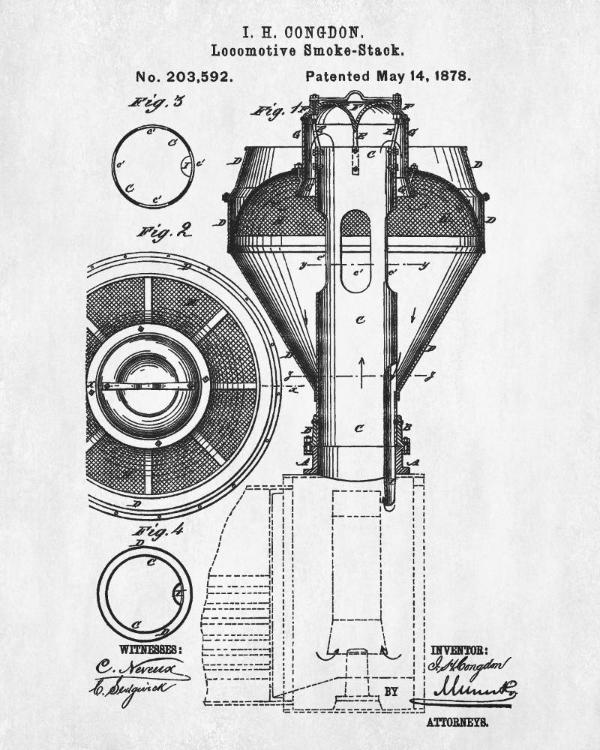 • Straight; modified with fluted cap – – observed between 1885 and 1889 (no further information) At least one photo shows the straight stack with fluted cap on DSP&P #116, but it is not known how many others may have received this stack. The configuration is interesting in that the straight stack stem appears to have at least (5), if not more, brass bands. • McConnell ("pancake") – circa 1896 Joseph Henry "J.H." McConnell (1843-1928) went to work for the Union Pacific Railroad in 1868, becoming Superintendent of Motive Power and Machinery in 1872, appears to have developed his smokestack design sometime before 1896. In 1901, he left the Union Pacific to become the manager of the Pittsburgh branch of the American Locomotive Works (ALCO) and is attributed as being one of the principal designers of the 4-6-2 "Pacific" class locomotive. NOTE: Although J.H. McConnell seems to have first published information on his smokestack in 1896, it may have already been in use prior to that time. One source suggests that McConnell smokestacks were in use from 1887-1900+. Unless I have missed it, I did not find a patent for the McConnell smokestack. 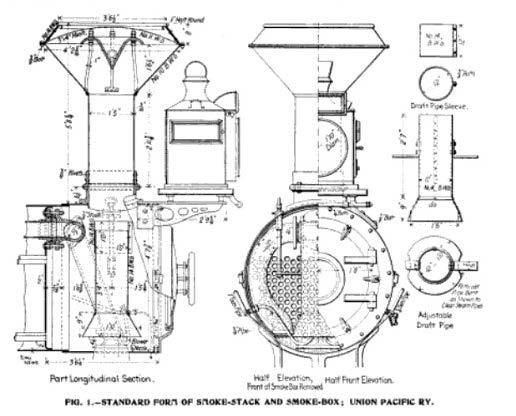 • Straight ("shotgun") – (various competing designs) • Straight; short stem with added "Diamond" – circa 1910 Several engines, to include C&S #13, #30, and #59, were equipped in about 1910 with an experimental diamond mounted on a relatively short straight stack stem. • Straight; modified with a Como "cone" spark arrester – circa 1911 • Straight; modified with a Ridgway ("Bear Trap") spark arrester – 1922 Harry W. Ridgway (1866-1945) of Denver, Colorado, received patent US 1,439,262 for his improved spark arrester on 19 Dec 1922, which he designed while working as Superintendent of Motive Power, Colorado Southern Railway. His name is often incorrectly spelled as "Ridgeway" with an "e." NOTE: Although the Ridgway "Bear Trap" was not patented until 1922, there are some indications it may have been going through trials as early as 1918 or so. 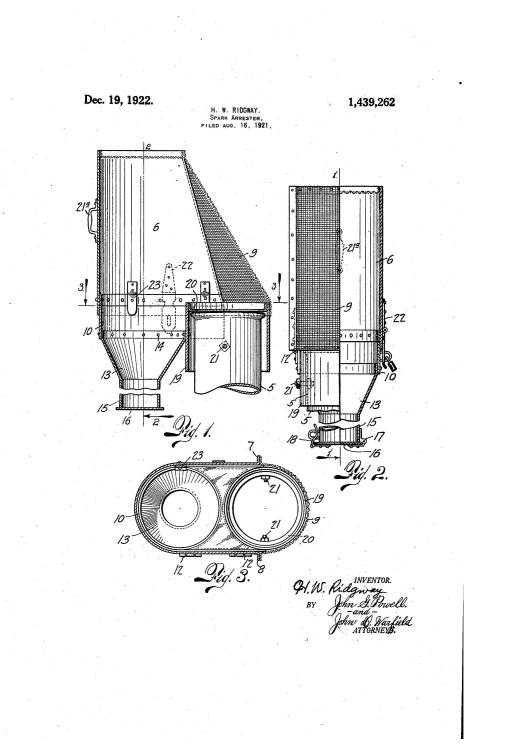 I am always very open to updates and corrections.
Craig H. Trout
|
Re: Using Engine Smokestacks to Estimate Photograph Dates...
|
Then there was this
 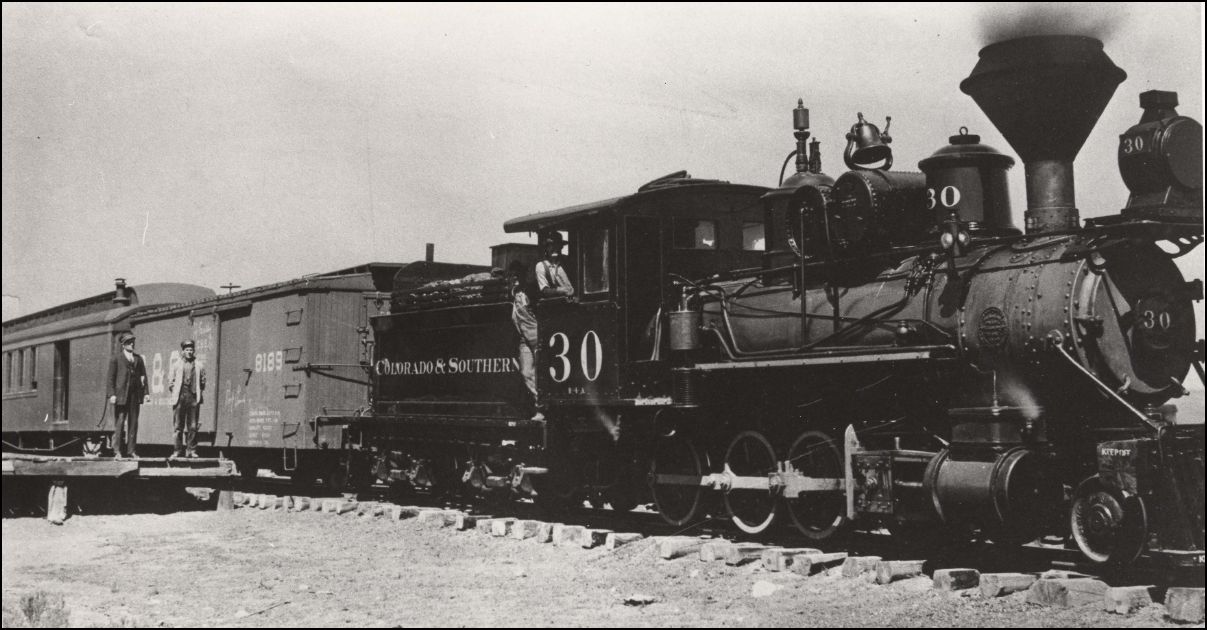
UpSideDownC
in New Zealand |
|
In reply to this post by chtrout
You need a lot of latitude, now quite possible to say when a particular style first came in, but when it was discontinued would be a very different call.
I remember one photo from Como which was given a date no later than but there were other clues that showed it must have been. |
Re: Using Engine Smokestacks to Estimate Photograph Dates...
|
The fluted/capped stack was earlier than 1900's .... note the DSP&P lettering on
the cab on the above photo. This would correspond with the timing of its use on other RR's as well. Being something of an aesthetically driven person, I never cared for the straight stacks during the ringed domes period (too plain), but have wondered for a long time, given the conteporary popularity for designing and selling a "better mousetrap" for spark control, ... what was the backstory on the capped/fluted straight stack ? They always seem to be combined with a long extended smokebox, suggesting the stack worked in conjuction with an internal smokebox design, the designers just taking artistic license with the stack's external presentation to keep with current Victorian norms by adding decorative gee-gaw.
"Duty above all else except Honor"
|
Re: Using Engine Smokestacks to Estimate Photograph Dates...
|
U&N 265 was delivered with an extended smokebox and fluted capped stack some time around 1886 but by the time they came to the South Park it had a short smokebox and diamond stack.Could there be any photo sources in Montana,Idaho,or Utah showing the Rhode Island consolidations in action on the U&N?Maybe with a capped stack?
|
Re: Using Engine Smokestacks to Estimate Photograph Dates...
|
Here is another oddity. Based on the date written on the rear - Como 1910
I grabbed the picture from eBay a while back. Sadly, there wasn't any additional data  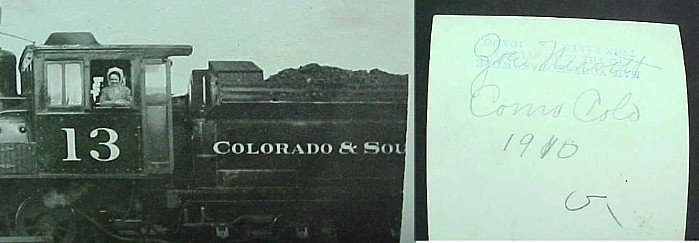
Doug Heitkamp
Centennial, CO |
Re: Using Engine Smokestacks to Estimate Photograph Dates...
|
30 had that same short "diamond-ish" stack very late, when most of
the fleet had gone to straight stacks. They look disproportionately small, particularly the height.
"Duty above all else except Honor"
|
Re: Using Engine Smokestacks to Estimate Photograph Dates...
|
Administrator
|
In reply to this post by Chris Walker
Right, Chris. I would categorize the picture of #30 ( and #13) as having what I attempted to describe earlier from memory, as a "pancake" stack. These first appeared around 1888, as I recall. Similar upper part as a McConnell, but definitely not a McConnell.
|
|
In reply to this post by South Park
Hey South Park,
Yes, great catch... DSP&P #74 (Cooke 1557, Feb 1884) had been renumbered as DSP&P #116 in 1885, DL&G retaining the same number in 1889, and finally becoming C&S #11 in 1899, and then dropped from the roster in 1918. That being said, this photo of DSP&P #116 would have to be between 1885 and 1889, and accordingly, the smokestack would have to date from that 4-year time frame... I have just edited and rearranged my listing to reflect this change.
Craig H. Trout
|
Re: Using Engine Smokestacks to Estimate Photograph Dates...
|
In reply to this post by Doug Heitkamp
This was part of an experiment that has been mentioned on this forum before.13,30 and 59 were temporarily re-equipped with those stacks to see if they could cut down on the number of grass fires
|
Re: Using Engine Smokestacks to Estimate Photograph Dates...
|
Yes, see "the diamond stacks of 1910" for a great discussion:
http://c-sng-discussion-forum.41377.n7.nabble.com/South-Park-Timeline-Footnote-The-Diamond-Stacks-of-1910-td3903.html Cheers, John
John Greenly
Lansing, NY |
Re: Using Engine Smokestacks to Estimate Photograph Dates...
|
In reply to this post by Chris Walker
By the way, there are excellent scans of the two photos of #30 with its 1910 stack in the Salida Archive Centennial photo collection:
http://salidaarchive.info/wp-content/uploads/2014/12/engine-30.jpg http://salidaarchive.info/wp-content/uploads/2014/12/c-and-s.jpg Click on these to enlarge, and they show beautiful fine detail. Someday I have to make one of these stacks. It just so happens that my C&S motive power consists of numbers 13, 30 and 59! Cheers, John
John Greenly
Lansing, NY |
Re: Using Engine Smokestacks to Estimate Photograph Dates...
|
Administrator
|
An odd thing about both #13 and #30 with what I refer to as "pancake" stacks, is that both smoke boxes have been extended as for straight shotgun stacks. Raises a case for continuing to find the best combination for fire abatement during this time.
|
«
Return to C&Sng Discussion Forum
|
1 view|%1 views
| Free forum by Nabble | Edit this page |

